Background parenchymal enhancement at breast MR imaging and breast cancer risk
- PMID: 21493794
- PMCID: PMC6939979
- DOI: 10.1148/radiol.11102156
Background parenchymal enhancement at breast MR imaging and breast cancer risk
Abstract
Purpose: To examine the relationships between breast cancer and both amount of fibroglandular tissue (FGT) and level of background parenchymal enhancement (BPE) at magnetic resonance (MR) imaging.
Materials and methods: A waiver of authorization was granted by the institutional review board for this retrospective HIPAA-compliant study. Among 1275 women who underwent breast MR imaging screening between December 2002 and February 2008, 39 breast carcinoma cases were identified. Two comparisons were performed: In one comparison, two normal controls--those of the women with negative (benign) findings at breast MR imaging--were matched to each breast cancer case on the basis of age and date of MR imaging. In the second comparison, one false-positive control--that of a woman with suspicious but nonmalignant findings at MR imaging--was similarly matched to each breast cancer case. Two readers independently rated the level of MR imaging-depicted BPE and the amount of MR imaging-depicted FGT by using a categorical scale: BPE was categorized as minimal, mild, moderate, or marked, and FGT was categorized as fatty, scattered, heterogeneously dense, or dense.
Results: Compared with the odds ratio (OR) for a normal control, the OR for breast cancer increased significantly with increasing BPE: The ORs for moderate or marked BPE versus minimal or mild BPE were 10.1 (95% confidence interval [CI]: 2.9, 35.3; P < .001) and 3.3 (95% CI: 1.3, 8.3; P = .006) for readers 1 and 2, respectively. Similar odds were seen when the false-positive controls were compared with the breast cancer cases: The ORs for moderate or marked BPE versus minimal or mild BPE were 5.1 (95% CI: 1.4, 19.1; P = .005) and 3.7 (95% CI: 1.2, 11.2; P = .013) for readers 1 and 2, respectively. The breast cancer odds also increased with increasing FGT, but the BPE findings remained significant after adjustment for FGT.
Conclusion: Increased BPE is strongly predictive of breast cancer odds.
Figures
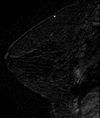
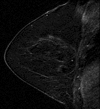

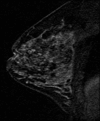

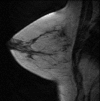
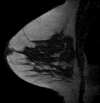

Similar articles
-
Effect of aromatase inhibitors on background parenchymal enhancement and amount of fibroglandular tissue at breast MR imaging.Radiology. 2012 Sep;264(3):670-8. doi: 10.1148/radiol.12112669. Epub 2012 Jul 6. Radiology. 2012. PMID: 22771878
-
Are Qualitative Assessments of Background Parenchymal Enhancement, Amount of Fibroglandular Tissue on MR Images, and Mammographic Density Associated with Breast Cancer Risk?Radiology. 2015 Aug;276(2):371-80. doi: 10.1148/radiol.2015142304. Epub 2015 May 12. Radiology. 2015. PMID: 25965809 Free PMC article.
-
Impact of menopausal status on background parenchymal enhancement and fibroglandular tissue on breast MRI.Eur Radiol. 2012 Dec;22(12):2641-7. doi: 10.1007/s00330-012-2553-8. Epub 2012 Jul 4. Eur Radiol. 2012. PMID: 22752463
-
Impact of Background Parenchymal Enhancement on Diagnostic Performance of Breast MRI: A Systematic Review and Meta-Analysis.Radiology. 2025 May;315(2):e241919. doi: 10.1148/radiol.241919. Radiology. 2025. PMID: 40423535
-
The Association of Background Parenchymal Enhancement at Breast MRI with Breast Cancer: A Systematic Review and Meta-Analysis.Radiology. 2019 Sep;292(3):552-561. doi: 10.1148/radiol.2019182441. Epub 2019 Jun 25. Radiology. 2019. PMID: 31237494
Cited by
-
Relationships between mammographic density, tissue microvessel density, and breast biopsy diagnosis.Breast Cancer Res. 2016 Aug 23;18(1):88. doi: 10.1186/s13058-016-0746-9. Breast Cancer Res. 2016. PMID: 27552842 Free PMC article.
-
Clinical application of magnetic resonance imaging in management of breast cancer patients receiving neoadjuvant chemotherapy.Biomed Res Int. 2013;2013:348167. doi: 10.1155/2013/348167. Epub 2013 Jun 5. Biomed Res Int. 2013. PMID: 23862143 Free PMC article. Review.
-
The value of imaging combined with clinicopathological features in the diagnosis of high-risk breast lesions.Gland Surg. 2022 Aug;11(8):1323-1332. doi: 10.21037/gs-22-155. Gland Surg. 2022. PMID: 36082087 Free PMC article.
-
Quantitative background parenchymal enhancement to predict recurrence after neoadjuvant chemotherapy for breast cancer.Sci Rep. 2019 Dec 16;9(1):19185. doi: 10.1038/s41598-019-55820-5. Sci Rep. 2019. PMID: 31844135 Free PMC article.
-
Multimodality Imaging of Breast Parenchymal Density and Correlation with Risk Assessment.Curr Breast Cancer Rep. 2019 Mar;11(1):23-33. doi: 10.1007/s12609-019-0302-6. Epub 2019 Jan 17. Curr Breast Cancer Rep. 2019. PMID: 35496471 Free PMC article.
References
-
- Wolfe JN. Risk for breast cancer development determined by mammographic parenchymal pattern. Cancer 1976;37(5):2486–2492. - PubMed
-
- Wolfe JN. Breast patterns as an index of risk for developing breast cancer. AJR Am J Roentgenol 1976;126(6):1130–1137. - PubMed
-
- Wolfe JN, Saftlas AF, Salane M. Mammographic parenchymal patterns and quantitative evaluation of mammographic densities: a case-control study. AJR Am J Roentgenol 1987;148(6):1087–1092. - PubMed
-
- van Gils CH, Hendriks JH, Holland R, et al. . Changes in mammographic breast density and concomitant changes in breast cancer risk. Eur J Cancer Prev 1999;8(6):509–515. - PubMed
-
- Byrne C, Schairer C, Wolfe J, et al. . Mammographic features and breast cancer risk: effects with time, age, and menopause status. J Natl Cancer Inst 1995;87(21):1622–1629. - PubMed
MeSH terms
Grants and funding
LinkOut - more resources
Full Text Sources
Medical

